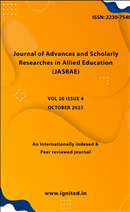Explore the Role of Ultrasound in Pediatric Radiology, Focusing on its safety, accuracy, and effectiveness in Diagnosing Various Pediatric Conditions
Keywords:
ultrasound, pediatric radiology, safety, accuracy, effectiveness, diagnosing, various pediatric conditions, chest ultrasound, pediatric heart surgery, postoperative complicationsAbstract
Background An ultrasound of the chest is a noninvasive diagnostic tool used to evaluate the lungs,mediastinum (the chest cavity that houses the heart, aorta, trachea, esophagus, thymus, and lymph nodes), andpleural space (the area between the lungs and the chest wall). Using ultrasound, the internal organs andstructures of the chest may be quickly and clearly seen from the outside. It is possible to evaluate heart and lungfunction using ultrasound. This research explores the perspectives of young patients who had emergency chestsurgery and afterwards underwent a series of radiography examinations. Aim The purpose of this research is tocompare the accuracy of bedside chest ultrasonography (CUS) and chest radiography (CXR) in assessingpostoperative complications after pediatric heart surgery. Methods One hundred and forty patients wereincluded in our analysis. IBM's version 25 of the SPSS statistical analysis program was used. Results NinetythreeCXRs were normal among a total of 140. In 47 chest x-rays, the surgeon saw anything out of the ordinary.Seventy-two of the CUS investigations found nothing out of the ordinary, whereas 68 did. Sixty-nine trials hadnormal results from both CUS and CXR. Kappa statistics revealed a very high level of agreement, with a Kappacoefficient of K=0.749 (p <0.0001). CUS has a sensitivity of 96.9, specificity of 84.75, PPV of 73.4, andNPV of 98.43. Conclusion Due to its excellent specificity, sensitivity, negative and positive predictive values,ultrasonography is deemed safe and useful for diagnosing chest surgery.References
Hryhorczuk AL, Restrepo R, Lee EY. Pediatric musculoskeletal ultrasound: practical imaging approach. Am J Roentgenol. 2016;206(5). 10.2214/AJR.15.15858.
Litrenta J, Masrouha K, Wasterlain A, Castaneda P. Ultrasound evaluation of pediatric orthopaedic patients. J Am Acad Orthop Surg. 2020;28(16):E696–E705. doi: 10.5435/JAAOS-D-17-00895.
Rodríguez Bandera AI, Sebaratnam DF, Feito Rodríguez M, de Lucas Laguna R. Cutaneous ultrasound and its utility in pediatric dermatology. Part I: Lumps, bumps, and inflammatory conditions. Pediatr Dermatol. 2020;37(1). 10.1111/pde.14033.
Bansal AG, Rosenberg HK. Sonography of pediatric superficial lumps and bumps: illustrative examples from head to toe. Pediatr Radiol. 2017;47(9). 10.1007/s00247-017-3859-0.
Shah SH, Callahan MJ. Ultrasound evaluation of superficial lumps and bumps of the extremities in children: a 5-year retrospective review. Pediatr Radiol. 2013;43(SUPPL. 1). 10.1007/s00247-012-2590-0.
Amorosa JK, Bramwit MP, Mohammed TL, Reddy GP, Brown K, Dyer DS et al. ACR appropriateness criteria routine chest radiographs in intensive care unit patients. J Am Coll Radiol 2013;10(3):170-74
Nicolaou S, Talsky A, Khashoggi K, Venu V. Ultrasound-guided interventional radiology in critical care. Crit Care Med 2007;35(5):S186-97
Berglund SR, Rocke DM, Dai J, et al. Transient genome-wide transcriptional response to low-dose ionizing radiation in vivo in humans. Int J Radiat Oncol Biol Phys 2008; 70:229 –34
Yin E, Nelson DO, Coleman MA, et al. Gene expression changes in mouse brain after exposure to low-dose ionizing radiation. Int J Radiat Biol 2003; 79:759 –75
Ali MA. Magnetic resonance imaging and associated alteration in some biophysical properties of blood. Rom J Biophys 2007; 17:277 – 86.
Simi S, Ballardin M, Casella M, et al. Is the genotoxic effect of magnetic resonance negligible? Low persistence of micronucleus frequency in lymphocytes of individuals after cardiac scan. Mutat Res 2008; 645:39 –43
Bonassi S, Znaor A, Ceppi M, et al. An increased micronucleus frequency in peripheral blood lymphocytes predicts the risk of cancer in humans. Carcinogenesis 2007; 28:625 –31
Kimura T, Takahashi K, Suzuki Y, et al. The effect of high strength static magnetic fields and ionizing radiation on gene expression and DNA damage in Caenorhabditis elegans. Bioelectromagnetics 2008; 29:605 –14
Jansson, Inger (2014) On the nature of work ability. Doctoral Thesis. School of Health Sciences Dissertation Series No 48. ISBN 978-91-85835-47-8
Axelsson, Anna Karin (2014) Children with profound intellectual and multiple disabilities and their participation in family activities. Doctoral Thesis. School of Health Sciences Dissertation Series No 49. ISBN 978-91-85835-48-5
Börjesson, Ulrika (2014) Everyday Knowledge in Elder Care. An Ethnographic Study of Care Work. Doctoral Thesis. School of Health Sciences Dissertation Series No 50. ISBN 978-91-85835-49-2
Cattarossi L. Lung ultrasound: its role in neonatology and pediatrics. Early Hum Dev 2013;89(Suppl. 1):S17–19.








